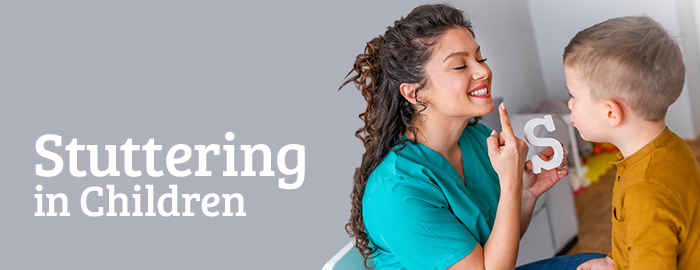Stuttering in Children
Stuttering is a fluency disorder that affects the ‘smoothness’ of speech. When the flow of speech is interrupted, it is due to the repetition of sounds, syllables, words, phrases, prolongations or ‘blocks’, which may impact the rhythm of speech production. Sometimes, secondary behaviours are associated with stuttering which include sound or word avoidances, facial grimaces and head movements.
The exact cause of stuttering is still unknown despite ongoing research; however, there is evidence to suggest that certain genetic and neurophysiological factors contribute to stuttering. The onset of stuttering can vary from sudden to gradual, with severity ranging from mild, moderate to severe.
 Stuttering can affect communication for children of all ages, however there is a higher incidence rate in 3-4-year-old children (Reilly et al., 2009) and also in boys (Yairi & Ambrose, 1999). Depending on several factors, it may be recommended to monitor your child’s stutter for 6 months prior to starting therapy to allow for spontaneous recovery. However, if there is family history of stuttering or if your child is getting upset or frustrated, then therapy may be started sooner than that. Some children may show signs of frustration or embarrassment about their stuttering, and this may affect their ability to socialise and engage with their peers or speak in front of the class during presentations. Stuttering can affect communication for children of all ages, however there is a higher incidence rate in 3-4-year-old children (Reilly et al., 2009) and also in boys (Yairi & Ambrose, 1999). Depending on several factors, it may be recommended to monitor your child’s stutter for 6 months prior to starting therapy to allow for spontaneous recovery. However, if there is family history of stuttering or if your child is getting upset or frustrated, then therapy may be started sooner than that. Some children may show signs of frustration or embarrassment about their stuttering, and this may affect their ability to socialise and engage with their peers or speak in front of the class during presentations.
Treatment for stuttering is highly individualised however, the Lidcombe Program (ages 2-6 years and 7-12) and the Camperdown Program (ages 13+ adolescence and adults), are two Evidence Based Practice (EBP) intervention programmes that a Speech Therapist may use for stuttering treatment. Several of the Speech Therapists at Dynamics are trained in both the Lidcombe Program and the Camperdown Program, so please get in contact to schedule an assessment and therapy if you have any concerns.

Below are a few tips when communicating with your child or someone who stutters:
- Remember that hesitations and repetitions are often a normal part of speech and language development
- Be patient and give your child enough time to complete what he or she is trying to say
- Don’t finish sentences for your child
- Don’t tell them to take a breath or slow down
- Don’t interrupt when your child stutters
|
|
There are a range of stuttering resources available online however, it is important to consult with your Speech and Language Therapist, in regards to your child’s fluency presentation.
Online resources:
References:
American Speech-Language-Hearing Association. (1993). Definitions of communication disorders and variations [Relevant Paper]. Retrieved from www.asha.org/policy/
Ambrose, N. G., & Yairi, E. (1999). Normative disfluency data for early childhood stuttering. Journal of Speech, Language, and Hearing Research, 42(4), 895-909.
Mansson, H. (2000). Childhood stuttering: Incidence and development. Journal of Fluency Disorders, 25, 47-57
Reilly, S., Onslow, M., Packman, A., Wake, M., Bavin, E., Prior, M., … Ukoumunne, O. C. (2009). Predicting stuttering onset by age 3: A prospective, community cohort study. Pediatrics, 123, 270-277.
Yairi, E., & Ambrose, N. G. (1999). Early childhood stuttering I: Persistency and recovery rates. Journal of Speech, Language, and Hearing Research, 42(5), 1097-1112.
|



